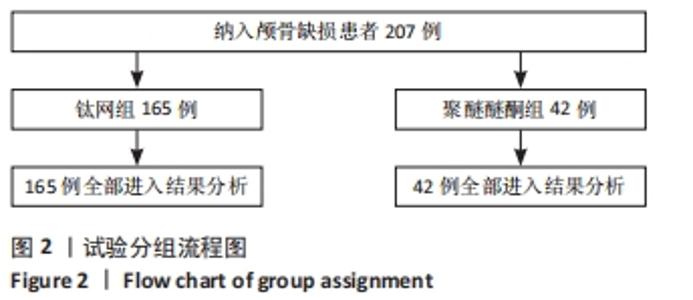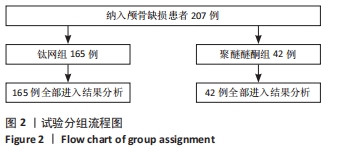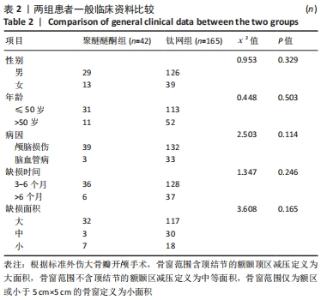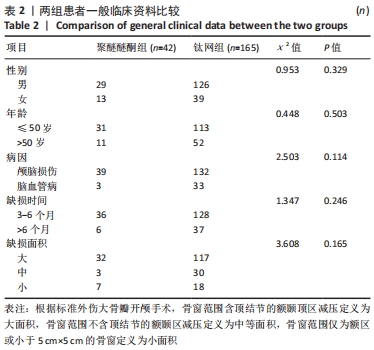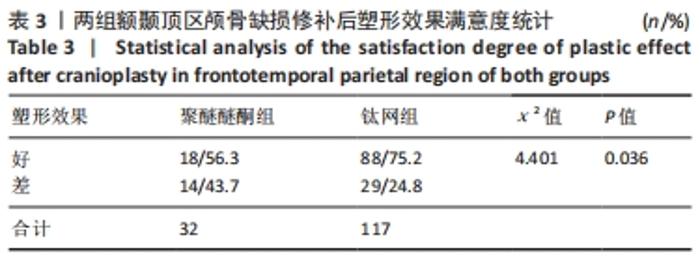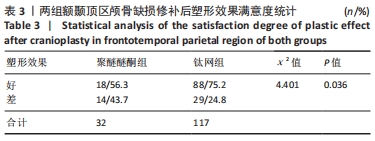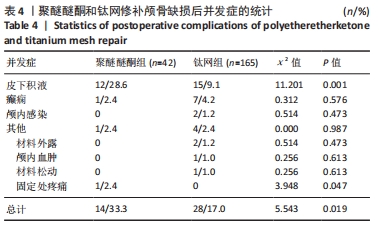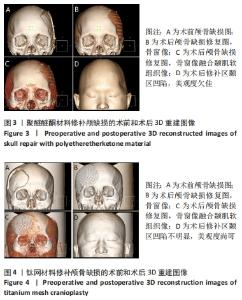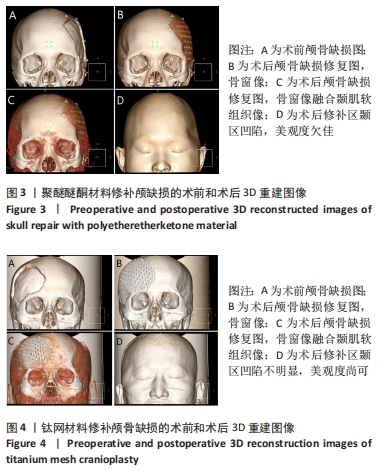[1] MAHAPURE KS, MURRAY DJ. “The historical timeline of cranioplasty”. J Plast Reconstr Aesthet Surg. 2021;74(3):632-633.
[2] OLIVEIRA A, AMORIM R, BRASIL S, et al. Improvement in neurological outcome and brain hemodynamics after late cranioplasty. Acta Neurochir (Wien). 2021;163(10):2931-2939.
[3] HATAMLEH MM. Contemporary Review on Craniectomy and Cranioplasty; Part 1: Decompressive Craniectomy. J Craniofac Surg. 2021. doi: 10.1097/SCS.0000000000008041.
[4] 宋洋,张恩刚,蔡廷江,等.数字成型钛网早期修补对颅骨缺损术后康复及美学效果的影响[J].临床外科杂志,2021,29(5):485-488.
[5] PIAZZA M, GRADY MS. Cranioplasty. Neurosurg Clin N Am. 2017;28(2): 257-265.
[6] 曹国定,裴豫琦,刘军,等.骨缺损修复材料的研究进展[J].中国骨伤,2021,34(4):382-388.
[7] NGUYEN PD, KHECHOYAN DY, PHILLIPS J H, et al. Custom CAD/CAM implants for complex craniofacial reconstruction in children: our experience based on 136 cases. J Plast Reconstr Aesthet Surg. 2018; 71(11):1609-1617.
[8] HENRY J, AMOO M, TAYLOR J, et al. Complications of Cranioplasty in Relation to Material: Systematic Review, Network Meta-Analysis and Meta-Regression. Neurosurgery. 2021;89(3):383-394.
[9] 林柳兰,周建勇.3D打印聚醚醚酮及其复合材料修复骨缺损的应用现况[J].中国组织工程研究,2020,24(10):1622-1628.
[10] ROSENTHAL G, NG I, MOSCOVICI S, et al. Polyetheretherketone implants for the repair of large cranial defects: a 3- center experience. Neurosurgery. 2014;75(5):523-529.
[11] ROSENTHAL G, NG I, MOSCOVICI S, et al. Polyetheretherketone implants for the repair of large cranial defects: a 3-center experience. Neurosurgery. 2014;75(5):523-529.
[12] SINGH S, SINGH R, JAIN K, et al. Cranioplasty following decompressive craniectomy-Analysis of complication rates and neurological outcomes:A single center study. Surg Neurol Int. 2019;19:142.
[13] 孙新林,王继辉,黄敏,等.聚醚醚酮与钛网在去骨瓣减压术后颅骨成形术中临床应用效果的单中心回顾性研究[J].中华神经医学杂志,2018,17(8):825-830.
[14] 孙玉晨,出良钊,董明昊,等.聚醚醚酮与钛网在颅骨成形术中应用体会[J].中国临床神经外科杂志,2018,23(2):103-104.
[15] 周剑云,张新,高海滨,等.聚醚醚酮与钛网治疗去骨瓣减压术后颅骨缺损效果的对比分析[J].中国微侵袭神经外科杂志,2021,26(1): 7-10.
[16] 王冬月,曲鑫.聚醚醚酮与钛网在颅骨修补整形术中应用效果比较[J].中国医师进修杂志,2021,44(1):49-53.
[17] 杨子彬.论植入体内医用材料的生物相容性[J].中国医疗器械信息, 2006,12(7):36-39.
[18] 汪茜芸,唐亮.PEEK种植体性能优化的研究进展[J].广东医学,2020, 41(13):1391-1394.
[19] 王悦,刘红.聚醚醚酮生物复合材料表面改性的研究进展[J].现代口腔医学杂志,2019,33(6):360-364.
[20] 胡均贤,袁玉明,赵德英,等. 二维和三维数字化塑形钛网修补颅骨后并发症的异同[J].中国组织工程研究,2018,22(18):2826-2830.
[21] 耿双双,赵宝红.增强钛种植体表面亲水性能研究进展[J].中国实用口腔科杂志,2016,9(6):368-372.
[22] 卢燃,陈溯,张振庭.钛表面改性提高种植体亲水性的研究进展[J].口腔颌面修复学杂志,2017,18(3):173-176.
[23] 范华杨,尹一佳,王铮,等.钛种植体表面壳聚糖涂层的作用与优势[J].中国组织工程研究,2018,22(34):5553-5558.
[24] ROSINSKI CL, PATEL S, GEEVER B, et al. A Retrospective Comparative Analysis of Titanium Mesh and Custom Implants for Cranioplasty. Neurosurgery. 2021;86(1):E15-E22.
[25] 王鹏,王志明,刘福增,等.改良式翻皮技巧对颞肌下颅骨修补术中颞肌功能的保护作用[J].局解手术学杂志,2021,30(7):612-615.
[26] 张忠.开颅手术后颞肌萎缩的原因分析及预防措施[J].河南外科学杂志,2017,23(1):17-18.
[27] 苏崇德,常鹏飞.额颞开颅颞前叶切除术中颞肌处理的技术问题[J].中华神经外科疾病研究杂志,2011,10(3):227-229.
[28] 王量,胡志奇,李世荣.颞肌的应用解剖学研究[J].重庆医学,2013, 42(29):3524-3526.
[29] Pierre B,Franck D,Franck E,et al.Contemporary Review on Craniectomy and Cranioplasty; Part 1: Decompressive Craniectomy. Craniofaci Surgery. 2017;105:783-789.
[30] PUNCHAK M, CHUNG LK, LAGMAN C, et al. Outcomes following polyetheretherketone (PEEK) cranioplasty: systematic review and meta-analysis. J Clin Neurosci. 2017;41:30-35.
[31] SORIANO-BARON H, NEWCOMB AGUS, MALHOTRA D, et al. Biomechanical Effects of an Oblique Lumbar PEEK Cage and Posterior Augmentation. World Neurosurg. 2019;126:e975-e981.
[32] TEKIN S, DEĞER Y, DEMIRCI F. Evaluation of the use of PEEK material in implant-supported fixed restorations by finite element analysis. Niger J Clin Pract. 2019;22(9):1252-1258.
[33] MOUNIR M, ATEF M, ABOU-ELFETOUH A, et al. Titanium and polyether ether ketone (PEEK) patient-specific sub-periosteal implants: two novel approaches for rehabilitation of the severely atrophic anterior maxillary ridge. Int J Oral Maxillofac Surg. 2018;47(5):658-664.
[34] BROCKETT CL, CARBONE S, ABDELGAIED A, et al.Influence of contact pressure, cross-shear and counterface material on the wear of PEEK and CFR-PEEK for orthopaedic applications. Mech Behav Biomed Mater. 2016;63:10-16.
[35] OUELLETTE ES, GILBERT JL. Properties and Corrosion Performance of Self-reinforced Composite PEEK for Proposed Use as a Modular Taper Gasket. Clin Orthop Relat Res. 2016;474(11):2414-2427.
[36] SCHROEDER S, BRAUN S, MUELLER U, et al. Carbon-fibre-reinforced PEEK: An alternative material for flexion bushings of rotating hinged knee joints. Mech Behav Biomed Mater. 2020;101:103434.
[37] 钟鸣谷,古机泳,张伟明,等.聚醚醚酮材料在颅骨缺损修补术中的应用效果研究[J].实用心脑肺血管病杂志,2021,29(3):110-113.
[38] ADAM B, JOSIE J, OLEH A, et al. Comparative Cost-Effectiveness of Cranioplasty Implants. Plast Surg (Oakv). 2020;28(1):29-39.
[39] ZHANG J, TIAN W, CHEN J, et al.The application of polyetheretherketone (PEEK) implants in cranioplasty. Brain Res Bull. 2019;153:143-149.
[40] ZANOTTI B, ZINGARETTI N, VERLICCHI A, et al. Cranioplasty: Review of Materials. Craniofac Surg. 2016;27(8):2061-2072.
[41] ASAAD M, TASLAKIAN EN, BANUELOS J, et al. Surgical and Patient-Reported Outcomes in Patients With PEEK Versus Titanium Cranioplasty Reconstruction. Craniofac Surg. 2020;34(4):388-396.
[42] BADHEY A, KADAKIA S, MOURAD M, et al.Calvarial Reconstruction. Semin Plast Surg. 2017;31(4):222-226.
[43] LIU L, LU ST, LIU AH, et al.Comparison of complications in cranioplasty with various materials: a systematic review and meta-analysis. Br J Neurosurg. 2020;34(4):388-396.
|
